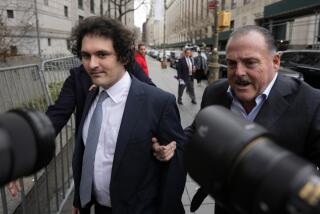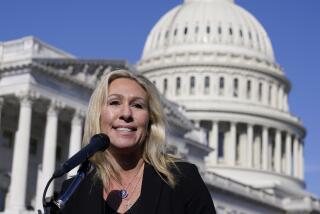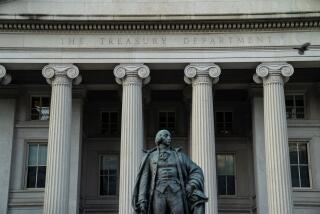Bank bailouts appear to be paying off
- Share via
Reporting from Washington and New York — The government’s bailout of the banking system is turning out to be far from the fiscal sinkhole so many had feared.
The $700-billion Troubled Asset Relief Program, known as TARP, was reluctantly created by Congress last fall despite criticism that it was a huge risk that would only encourage the profligate ways of Wall Street. But in recent months, tens of billions of dollars have begun flowing back from banks to the U.S. Treasury.
Bank of America Corp.’s decision this week to repay one of the largest chunks -- $45 billion -- reflects the stunning turnaround of the financial industry and demonstrates that the government’s unpopular medicine appears to have saved the patient. And the price tag isn’t as large as expected.
“It turns out, actually, TARP -- as wildly unpopular as it has been -- has been much cheaper than any of us anticipated,” President Obama said Thursday at a White House summit on creating jobs.
Federal Reserve Chairman Ben S. Bernanke, who pushed for the fund’s creation, made a similar point at a Senate hearing Thursday on his nomination to a second term.
“Unlike some of the scare stories about $700 billion being thrown away, I do believe . . . in the end that there’ll be something close to a break-even there,” Bernanke said.
The TARP fund may break even, that is, on its first and biggest use of taxpayer money: investing billions -- $205 billion as of Monday -- directly in banks.
Including Bank of America’s expected repayment, $116 billion -- more than half -- of that amount has already come back to the government, along with about $10 billion in dividends and interest.
One expert, however, predicts the TARP fund will end up as much as $150 billion in the red because of losses on additional uses that the Bush and Obama administrations found for the program’s money.
Totaling $270 billion so far, with commitments to spend about $160 billion more, those add-on uses include higher-risk investments in American International Group Inc., General Motors Co. and Chrysler. Little of that money has come back. The add-ons also include expenditures on incentives to boost small-business and consumer lending and to encourage mortgage firms to modify home loans.
And more TARP dollars might be heading out the door. Lawmakers and the Obama administration are considering using some of the remaining money to offset the cost of new job creation efforts. Any money used that way would not be repaid into the fund.
Also, the White House is not expected to allow TARP to expire at the end of the year. The law allows for a nearly automatic extension until October 2010.
“It’s great that some financial institutions are paying the money back. It’s not going to be so great if this administration immediately takes this money and shoves it out the door for some other big government boondoggle,” said Rep. Jeb Hensarling (R-Texas), who serves on the Congressional Oversight Panel for TARP and wants the program shut down.
One reason the TARP fund has gotten a substantial sum of money back is that BofA and other financial giants desperately wanted to get out from under the government’s heel on the issue of executive pay. Leaving TARP left them free to pay the lavish salaries to which their executives have become accustomed. Compensation limits under TARP have hampered BofA’s search for a successor to Chief Executive Kenneth D. Lewis, who is set to retire Dec. 31.
Another motivation to pay back TARP money is being able to stop making dividend payments to the government. Those dividends currently equal 5% on most of the money invested by the Treasury and 8% on a second round of infusions that went to Bank of America and Citigroup Inc.
The repayments also reflect Wall Street’s stunning resilience. The rest of the country may only be groggily recovering from recession, but many Wall Street firms are solidly back in the black.
Plain-vanilla banks, however, are still dealing with piles of bad loans that could get worse or more numerous as foreclosures keep surging and unemployment remains high. Ironically, many of those bad loans represented a big portion of the troubled assets that TARP was initially designed to purchase. The fund has done little to address that problem directly, however, spending only $27 billion on an initiative to buy up “toxic” mortgage assets in partnership with private investors.
Days after TARP was signed into law, the Bush administration decided the money was needed more urgently to thaw the frozen credit system. The Treasury soon began pumping billions into major banks in exchange for equity stakes.
Mark Zandi, chief economist at Moody’s Economy.com, said TARP would have been more effective if it instead had been used to buy troubled assets, as originally intended. Still, the capital infusions helped quell financial panic, even if it proved highly unpopular with the public because it bailed out firms that helped cause the crisis, he said.
Zandi estimated that all but $100 billion to $150 billion would be returned to taxpayers, a much better return than predicted last fall. But that won’t change the American public’s opinion of the program, he said.
“They’re still going to say it cost us $100 billion to $150 billion and all it did was save Wall Street,” Zandi said. “There’s no way to sugarcoat this: TARP is a black mark on our economic history. But we had to do it. The world without it would have been immeasurably darker.”
There’s a widespread consensus that TARP shored up confidence in the global financial sector and paved the way for a dramatic rebound in Wall Street profits.
“The end result is hard to debate,” said Adam Sussman, research director at Tabb Group, a research firm. “The banks are more stable now than when TARP was initiated. Overall the efforts to restore financial stability have been successful by any measure.”
But even some on Wall Street acknowledge that a secondary rationale offered for the infusions of government capital into banks -- that a restored financial sector would help the economy rebound -- hasn’t panned out.
“This worked extraordinarily well for Wall Street, but it has failed utterly for the real world,” said Don Putnam, managing partner at Grail Partners, a boutique investment bank in San Francisco.
TARP and other government programs breathed life into the financial markets, which boosted demand for basic Wall Street services such as stock trading, corporate capital raising and the construction of exotic, often lucrative financial instruments known as derivatives.
But some analysts worry because TARP didn’t help banks purge the mountains of toxic assets that sparked the financial crisis, which could restrain their lending going forward.
“TARP has given us the illusion that the banks are on the mend,” said Christopher Whalen, managing director of Institutional Risk Analytics in Torrance. “But the losses that banks face on some assets are going to be so big that the real economy is going to end up dying before the banks can heal themselves.”
Not everyone is so glum.
Many see the resurgence of Wall Street as a crucial first step toward broader recovery. But the resuscitation of the banking industry could be short-lived if unemployment stays high and consumers remain wary of spending.
“The financial sector’s recovery won’t last unless there is a subsequent recovery in the broader economy,” Sussman said. “So far what’s happened has been good, but it doesn’t mean we can breathe a sigh of relief yet.”
For that reason, Zandi said the Obama administration should extend the TARP program, even if that limits the potential return to taxpayers.
“I don’t think we can declare that the coast is clear,” he said. “We need to have this as an insurance policy.
jim.puzzanghera@ latimes.com
More to Read
Inside the business of entertainment
The Wide Shot brings you news, analysis and insights on everything from streaming wars to production — and what it all means for the future.
You may occasionally receive promotional content from the Los Angeles Times.











